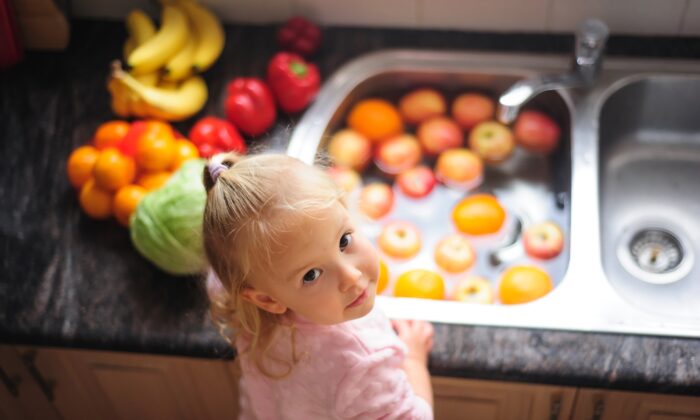
The best way to wash fruit and vegetables
“First do no harm” Hippocrates
Not only is this good advice for any doctor, it’s equally important when it comes to preparing food for our children. We need to make sure that we aren’t inadvertently giving them anything harmful. This means making sure we wash our fruit and veggies properly so that that there are no nasties lingering on the food we give our children.
The nasties I’m referring to include:
- Microorganisms (bacteria, viruses and parasites)
- Chemical pesticides
Microorganisms like E.coli, Salmonella, Listeria and Giardia typically cause food poisoning. This can range from mild tummy pains to much more severe symptoms. If you’ve ever had food poisoning, you know exactly what I’m talking about! Usually it’s an awful illness that children recover from in a few days.
The impact of eating pesticides however is more long term. Although all pesticide use is regulated and deemed “safe for ingestion” at low levels, we really don’t know the full impact on our children’s health. We do know though that the risk of pesticides is higher in children than in adults. This is because children ingest more per kilogram of body weight and are more vulnerable to exposure as they are actively growing and developing. There are numerous published studies showing associations of pesticide exposure to lower IQ, behavioural problems and certain cancers. It’s also important to note that although an individual pesticide may have been tested it’s impossible to test the dangers of the cocktail of chemicals our children are chronically exposed to.
Enough reasons for me to want to avoid them that’s for sure!!
An easy way to minimise the dangers of microorganisms & pesticides is thoroughly washing all fruit & vegetables.
I will discuss organic produce in another blog.
My guide to washing fruit and vegetables:
There are lots of methods and products out there, but looking at the literature it seems that these methods come out top:
- Washing under cold running water. The easiest and quickest option. It should be cold as warm water can actually encourage some chemicals to be absorbed into food. A stronger pressure is helpful. Whilst under the water, rub the produce with your hands, a cloth or a vegetable brush for the harder fruits and vegetables.
- Soaking in water and bicarbonate soda (also known as baking soda) mix. This will remove more than running water alone but requires more time. The bicarb alkalinises the water which seems to help break down and remove certain pesticides.
My method:
Add 1 tablespoon bicarb per 500ml water in a clean sink or bowl. Soak fruit & vegetables for 10 minutes. Then rinse off thoroughly under running water whilst rubbing or brushing. Dry properly and eat 🙂
Note: softer fruits and vegetables (e.g. berries and mushrooms) can’t be soaked. For these I rinse and then pat dry with a paper towel.
Although a lot of people do, I don’t use vinegar. I don’t like the after taste of it. I also couldn’t find evidence it was any better than the above. The same goes for the premade washing solutions you can buy
Other tips:
- Buy whole fruit and vegetables not pre-cut
- Wash hands before and after any food prep
- Wash produce before peeling
- Wash produce before cutting
- Make sure absolutely dry after washing and before storing (although I prefer to wash just before using)
I hope you found this useful. Please sign up to my newsletter to be the first to receive all my health tips.
